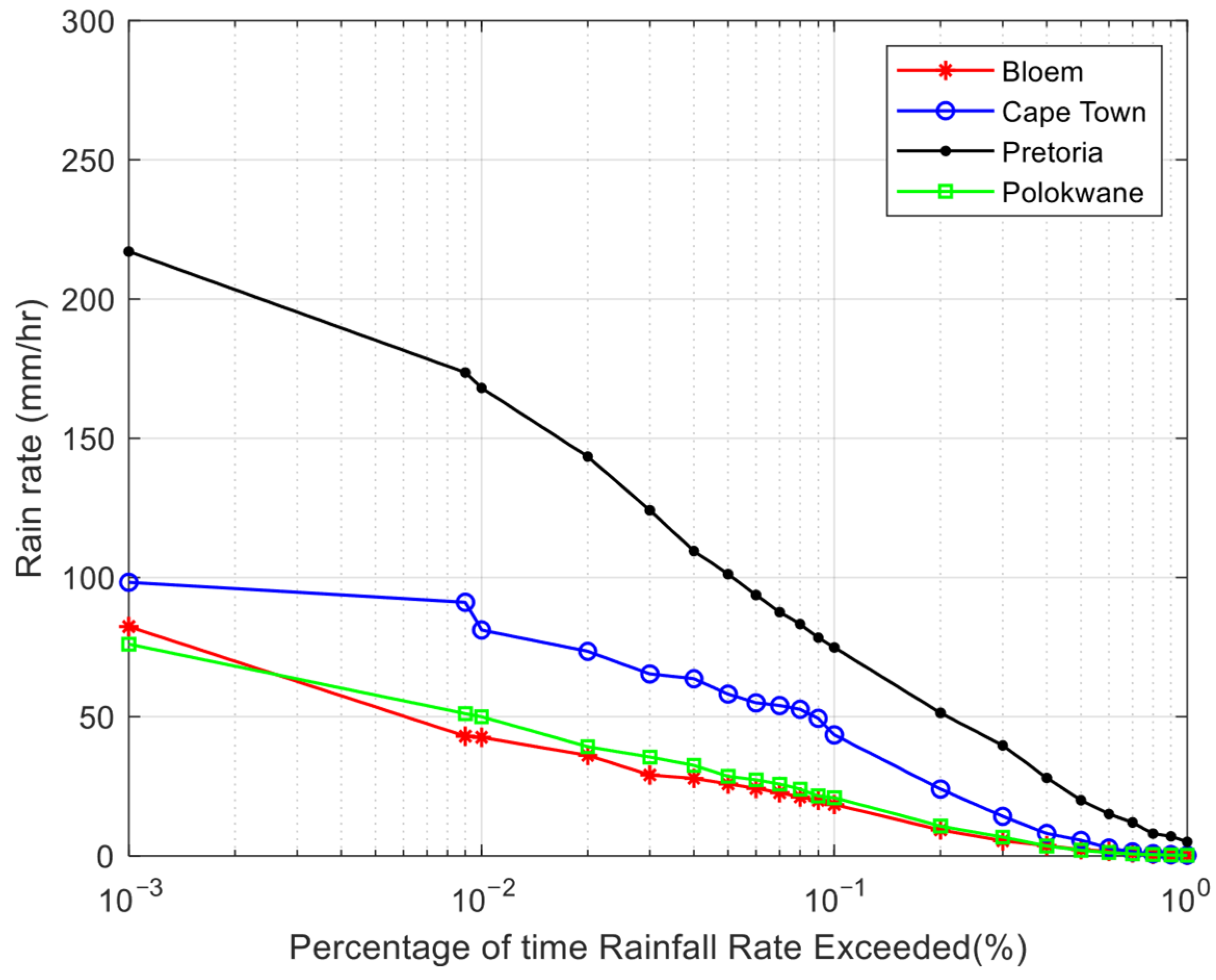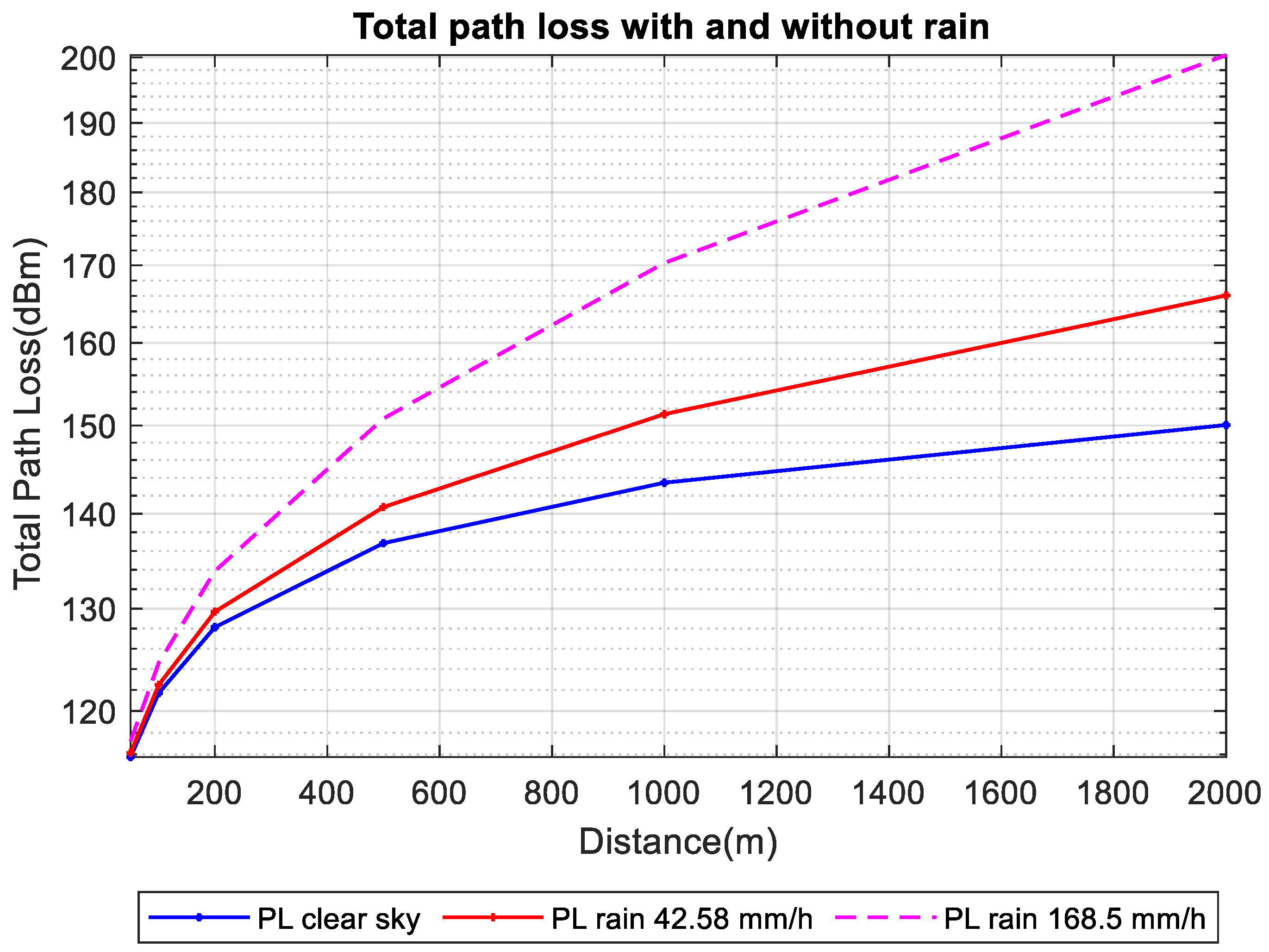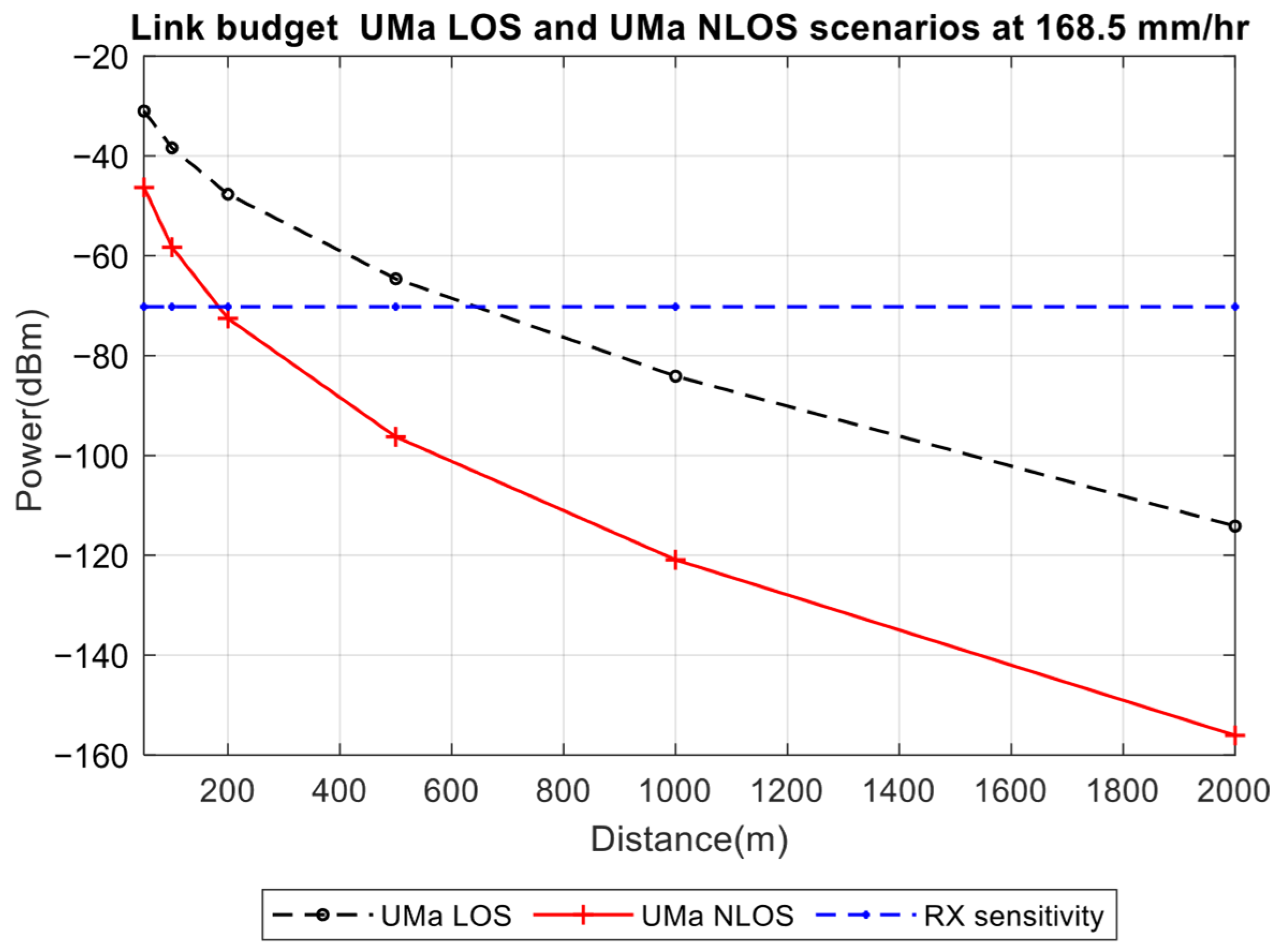Impact of Rain Attenuation on Path Loss and Link Budget in 5G mmWave Wireless Propagation Under South Africa’s Subtropical Climate
Abstract
1. Introduction
2. Related Work
3. Rain Attenuation
4. Path Loss
5. Link Budget
5.1. Channel Status
5.2. Parameter Sensitivity Analysis
6. Results and Discussion
6.1. Path Loss Analysis
6.2. Link Budget Analysis
6.3. LOS and NLOS Impact
7. Conclusions
Author Contributions
Funding
Data Availability Statement
Conflicts of Interest
Abbreviations
| 5G | Fifth generation (mobile network technology) |
| mmWave | Millimetre wave |
| GHz | Gigahertz |
| LOS | Line-of-sight |
| NLOS | Non-line-of-sight |
| UE | User equipment |
| BS | Base station |
| UMi | Urban micro |
| UMa | Urban macro |
| RxSL | Received signal level |
| RxS | Receiver sensitivity |
| SNR | Signal-to-noise ratio |
| ITU-R | International Telecommunication Union—Radiocommunication Sector |
| CI | Close-In |
| FI | Floating intercept |
| A0.01 | Attenuation exceeded for 0.01% of the time |
| dB | Decibel |
| SISO | Single-input single-output |
| MIMO | Multiple-input multiple-output |
References
- Cox, C. An Introduction to 5G: The New Radio, 5G Network and Beyond; John Wiley & Sons: West Sussex, UK, 2020; pp. 1–89. [Google Scholar]
- Lin, X.; Lee, N. Introduction to 5G and beyond. In 5G and Beyond: Fundamentals and Standards; Springer: Cham, Switzerland, 2021; pp. 1–25. [Google Scholar]
- Ojo, J.; Ajewole, M.; Sarkar, S. Rain rate and rain attenuation prediction for satellite communication in Ku and Ka bands over Nigeria. Prog. Electromagn. Res. B 2008, 5, 207–223. [Google Scholar] [CrossRef]
- Isabona, J.; Imoize, A.L.; Rawat, P.; Jamal, S.S.; Pant, B.; Ojo, S.; Hinga, S.K. Realistic prognostic modeling of specific attenuation due to rain at microwave frequency for tropical climate region. Wirel. Commun. Mob. Comput 2022, 2022, 8209256. [Google Scholar] [CrossRef]
- Shi, J.S.; Siat, L.J.; Hong, Y.L. Atmospheric impairments and mitigation techniques for high-frequency earth-space communication system in heavy rain region: A brief review. Int. J. Integr. Eng. 2019, 11, 159–168. [Google Scholar]
- Ananya, S.T.; Islam, S.; Mahmud, A.R.; Podder, P.K.; Uddin, J. Atmospheric propagation impairment effects for wireless communications. Int. J. Wirel. Mob. Netw 2020, 12, 45–61. [Google Scholar] [CrossRef]
- Goldsmith, A.J.; Varaiya, P.P. Capacity of fading channels with channel side information. IEEE Trans. Inf. Theory 1997, 43, 1986–1992. [Google Scholar] [CrossRef]
- 3GPP. 3rd Generation Partnership Project Technical Specification Group Radio Access Network Study on Channel Model for Frequencies from 0.5 to 100 GHz (Release 18). In TR38.9012024. p. 98. Available online: https://www.freecalypso.org/pub/pub/GSM/3GPP/archive/36_series/36.300/36300-b70.pdf (accessed on 25 May 2022).
- Li, X.; Xie, L.; Zheng, X. The comparison between the Mie theory and the Rayleigh approximation to calculate the EM scattering by partially charged sand. J. Quant. Spectrosc. Radiat. Transf. 2012, 113, 251–258. [Google Scholar] [CrossRef]
- Wriedt, T. Mie theory: A review. In The Mie Theory: Basics and Applications; Springer Series in Optical Sciences; Springer: Berlin/Heidelberg, Germany, 2012; Volume 169, pp. 53–71. [Google Scholar]
- Bohren, C.F.; Huffman, D.R. Absorption and Scattering of Light by Small Particles; John Wiley & Sons: Hoboken, NJ, USA, 2008. [Google Scholar]
- Recommendation, I. Prediction Methods Required for the Design of Terrestrial Free-Space Optical Links; International telecommunication Union: Geneva, Switzerland, 2007; p. 1814. [Google Scholar]
- Afullo, T.J.O. Raindrop size distribution modeling for radio link design along the eastern coast of South Africa. Prog. Electromagn. Res. B 2011, 34, 345–366. [Google Scholar] [CrossRef]
- Rappaport, T.S.; MacCartney, G.R.; Sun, S.; Yan, H.; Deng, S. Overview of millimeter wave communications for fifth-generation (5G) wireless networks—With a focus on propagation models. IEEE Trans. Antennas Propag. 2017, 65, 6213–6230. [Google Scholar] [CrossRef]
- Ratul, R.H.; Zaman, S.M.; Chowdhury, H.A.; Sagor, M.Z.H.; Kawser, M.T.; Nishat, M.M. Atmospheric influence on the path loss at high frequencies for deployment of 5g cellular communication networks. In Proceedings of the 2023 14th International Conference on Computing Communication and Networking Technologies (ICCCNT), Delhi, India, 6–8 July 2023. [Google Scholar]
- Yunida, Y.; Maulana, A.; Nasaruddin, N. Performance Analysis of Pathloss Model for 5G mm Wave Communication System at 24 GHz, 30 GHz, and 32 GHz. In Proceedings of the 2023 2nd International Conference on Computer System, Information Technology, and Electrical Engineering (COSITE), Banda Aceh, Indonesia, 2–3 August 2023. [Google Scholar]
- Zhao, X.; Wang, Q.; Geng, S.; Zhang, Y.; Zhang, J.; Li, J. Path loss modification and multi-user capacity analysis by dynamic rain models for 5G radio communications in millimetre waves. IET Commun. 2019, 13, 1488–1496. [Google Scholar] [CrossRef]
- Chuan, L.L.; Roslee, M.B.; Sudhamani, C.; Mousa, I.M.S.; Waseem, A.; Osman, A.F.; Zaharah, A.F.; Ullah, Y. Impact of Rainfall on 5G Millimeter Wave Channels. Prog. Electromagn. Res. C 2024, 148, 97–107. [Google Scholar] [CrossRef]
- Rec, I. itu-r p. 838–3. Specific Attenuation Model for Rain for Use in Prediction Methods. International Telecommunication Union-ITU, fevereiro 2005: P. 838-3. Available online: https://www.itu.int/dms_pubrec/itu-r/rec/p/r-rec-p.838-3-200503-i!!pdf-e.pdf (accessed on 25 May 2022).
- Crane, R. Prediction of attenuation by rain. IEEE Trans. Commun. 1980, 28, 1717–1733. [Google Scholar] [CrossRef]
- Moupfouma, F. Electromagnetic waves attenuation due to rain: A prediction model for terrestrial or LOS SHF and EHF radio communication links. J. Infrared Millim. Terahertz Waves 2009, 30, 622–632. [Google Scholar] [CrossRef]
- Yusuf, A.A.; Falade, A.; Olufeagba, B.; Mohammed, O.; Rahman, T.A. Statistical evaluation of measured rain attenuation in tropical climate and comparison with prediction models. J. Microw. Optoelectron. Electromagn. Appl. 2016, 15, 123–134. [Google Scholar] [CrossRef]
- Ulaganathen, K.; Rahman, T.B.A.; Abdulrahman, A.Y.; Abd Rahim, S.K.B. Comparative studies of the rain attenuation predictions for tropical regions. Prog. Electromagn. Res. M 2011, 18, 17–30. [Google Scholar] [CrossRef]
- Ojo, J.; Adedayo, K.; Uchegbu, A. Evaluation of Simulated Rain-Based Attenuation Techniques at kv Frequency Bands for Satellite Services Under Different Modulation Techniques over Southwestern Nigeria. 2021. Available online: https://academicjournals.org/journal/IJPS/article-full-text-pdf/81DB02265819 (accessed on 25 May 2022).
- Dias, W.D.; Carleti, M.; Moreira, S.S.L.; Mendes, L.L. Evaluation of rain attenuation model s in satellite links under tropical and equatorial climates. IEEE Lat. Am. Trans. 2018, 16, 358–367. [Google Scholar] [CrossRef]
- ITU. P.837: Characteristics of Precipitation for Propagation Modelling. Available online: https://www.itu.int/rec/R-REC-P.837/ (accessed on 25 May 2022).
- Rappaport, T.S.; MacCartney, G.R.; Samimi, M.K.; Sun, S. Wideband millimeter-wave propagation measurements and channel models for future wireless communication system design. IEEE Trans. Commun. 2015, 63, 3029–3056. [Google Scholar] [CrossRef]
- Sun, S.; Rappaport, T.S.; Rangan, S.; Thomas, T.A.; Ghosh, A.; Kovacs, I.Z.; Rodriguez, I.; Koymen, O.; Partyka, A.; Jarvelainen, J. Propagation path loss models for 5G urban micro-and macro-cellular scenarios. In Proceedings of the 2016 IEEE 83rd Vehicular Technology Conference (VTC Spring), Nanjing, China, 15–18 May 2016. [Google Scholar]






| Model | Key Assumptions | Limitations | South-Africa-Specific Limitations |
|---|---|---|---|
| ITU-R P.838-3 [19] | Based on global statistical averages | Limited in high-rain-rate scenarios | Lacks calibration for intense convective storms |
| 3GPP TR 38.901 [8] | Urban-deployment-focused, generalized LOS/NLOS | No region-specific rain handling | Does not model rain-induced fading dynamically |
| Crane Global Model [20] | Empirical, based on satellite and US datasets | Underperforms in tropical zones | Parameters not tuned for subtropical rainfall variability |
| Moupfouma [21] | Tailored for tropical regions, scalable | Less known, limited global use | Suited to South Africa’s rainfall profile (used here) |
| Reference | Location/Climate | Models Compared | Key Finding |
|---|---|---|---|
| [23] | Malaysia (tropical) | ITU-R, Moupfouma, Silva-Mello, Lin | Moupfouma outperforms ITU-R at higher rainfall |
| [3] | Nigeria (tropical) | Moupfouma for rain rate + ITU-R | Local rain rate modelling is more accurate |
| [22] | Malaysia (equatorial) | ITU-R vs. other empirical models | ITU-R underestimates attenuation; |
| [24] | Nigeria/Lagos | Moupfouma, ITU-R, Garcia Lopez | Moupfouma has lowest RMS prediction error |
| [25] | Brazil (tropical) | ITU, Crane, new model | New, localized model outperforms ITU and Crane |
| BS Interface 5G Ran | |
|---|---|
| Cell radius/max distance (m) | 10, 50, 100, 200, 500, 1000, 2000 |
| gNB (antenna) height | 10 m (UMi), 25 m (UMa) |
| Tx power per PRB (dBm) | 50 |
| Tx antenna count | 1 |
| Rx antenna count | 1 |
| Antenna gain | 17 dB |
| CA type | Single band |
| CA configuration | N257 (28 GHz) |
| DL:UL ratio | 4:1 |
| F-Low (MHz) | 26,500 |
| F-High (MHz) | 29,500 |
| Central frequency (MHz) | 28,000 |
| Numerology | 3 |
| Channel bandwidth (MHz) | 200 MHz |
| Number of RB | 125 |
| MCS table | 16QAM |
| Outdoor scenario | UMi, UMa |
| Path loss model | CI |
| Body loss | 15 dB |
| Slow fading margin | 7 |
| LOS probability | 0 or 1 |
| Foliage Loss | 8 |
| Fading and beamforming | No Fading |
| O2l building penetration model | Low loss model |
| UE 5G Ran Configuration | |
|---|---|
| Noise figure | 9 dB |
| Antenna height | 1.5 m |
| Cable loss | 0 dB |
| Antenna gain | 0 |
| Target SINR | 12 dB |
| Scenario | Rain Rate (mm/h) | Max Reliable Distance (m) | Link Margin at Max Distance (dB) |
|---|---|---|---|
| UMi LOS | 42.58 | 200 | ~10.0 |
| UMi NLOS | 42.58 | 200 | ~0.0 |
| UMa LOS | 42.58 | 1300 | ~0.0 |
| UMa NLOS | 42.58 | 190 | ~0.0 |
| UMi LOS | 168.5 | 200 | –5.0 |
| UMi NLOS | 168.5 | 160 | 0 |
| UMa LOS | 168.5 | 600 | –3.2 |
| UMa NLOS | 168.5 | 200 | –1.5 |
Disclaimer/Publisher’s Note: The statements, opinions and data contained in all publications are solely those of the individual author(s) and contributor(s) and not of MDPI and/or the editor(s). MDPI and/or the editor(s) disclaim responsibility for any injury to people or property resulting from any ideas, methods, instructions or products referred to in the content. |
© 2025 by the authors. Licensee MDPI, Basel, Switzerland. This article is an open access article distributed under the terms and conditions of the Creative Commons Attribution (CC BY) license (https://creativecommons.org/licenses/by/4.0/).
Share and Cite
Matondo, S.B.; Owolawi, P.A. Impact of Rain Attenuation on Path Loss and Link Budget in 5G mmWave Wireless Propagation Under South Africa’s Subtropical Climate. Telecom 2025, 6, 66. https://doi.org/10.3390/telecom6030066
Matondo SB, Owolawi PA. Impact of Rain Attenuation on Path Loss and Link Budget in 5G mmWave Wireless Propagation Under South Africa’s Subtropical Climate. Telecom. 2025; 6(3):66. https://doi.org/10.3390/telecom6030066
Chicago/Turabian StyleMatondo, Sandra Bazebo, and Pius Adewale Owolawi. 2025. "Impact of Rain Attenuation on Path Loss and Link Budget in 5G mmWave Wireless Propagation Under South Africa’s Subtropical Climate" Telecom 6, no. 3: 66. https://doi.org/10.3390/telecom6030066
APA StyleMatondo, S. B., & Owolawi, P. A. (2025). Impact of Rain Attenuation on Path Loss and Link Budget in 5G mmWave Wireless Propagation Under South Africa’s Subtropical Climate. Telecom, 6(3), 66. https://doi.org/10.3390/telecom6030066






